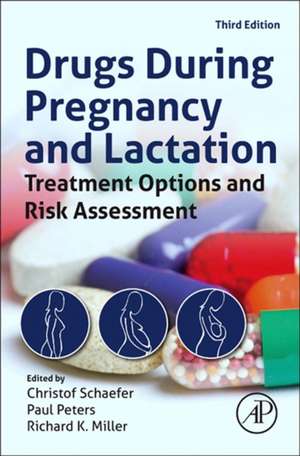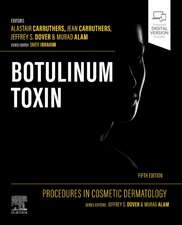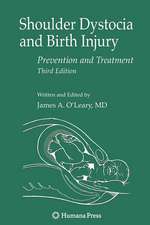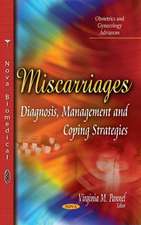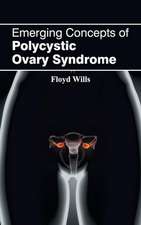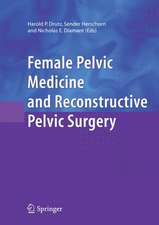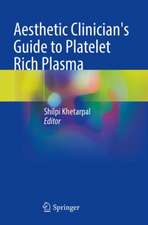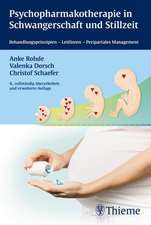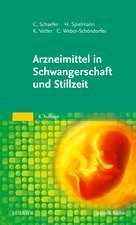Drugs During Pregnancy and Lactation: Treatment Options and Risk Assessment
Editat de Christof Schaefer, Paul W.J. Peters, Richard K Milleren Limba Engleză Hardback – 8 oct 2014
- Provides evidence-based recommendations to help clinicians make appropriate recommendations
- Uniquely organized and structured according to drug class and treatment indications to offer authoritative clinical content on potential adverse effects
- Highlights new research developments from primary source about working mechanism of substances that cause developmental disorders
Preț: 424.85 lei
Preț vechi: 514.79 lei
-17% Nou
Puncte Express: 637
Preț estimativ în valută:
81.32€ • 84.57$ • 68.14£
81.32€ • 84.57$ • 68.14£
Carte tipărită la comandă
Livrare economică 07-21 martie
Livrare express 06-12 februarie pentru 147.33 lei
Preluare comenzi: 021 569.72.76
Specificații
ISBN-13: 9780124080782
ISBN-10: 0124080782
Pagini: 918
Dimensiuni: 152 x 229 x 41 mm
Greutate: 1.63 kg
Ediția:Revised
Editura: ELSEVIER SCIENCE
ISBN-10: 0124080782
Pagini: 918
Dimensiuni: 152 x 229 x 41 mm
Greutate: 1.63 kg
Ediția:Revised
Editura: ELSEVIER SCIENCE
Public țintă
Clinicians who prescribe medicinal products to pregnant or lactating women, clinical pharmacologists, toxicologists and teratology information specialists, pharmacistsCuprins
1. General Commentary on drug therapy and drug risks in pregnancy
2. Specific drug therapties during pregnancy
2.1 Analgesics, non-steroidal anti-inflammatory drugs (NSAIDs), muscle relaxants, and antigout medications
2.2 Allergy and hyosensitization therapy
2.3 Antiasthmatic and cough medication
2.4 Nausea and vomiting in pregnancy
2.5 Gastro-intestinal medications, hyoplipidemic agents and spasmolytics
2.6 Anti-infective Agents
2.7 Vaccines and immunoglobulins
2.8 Heart and blood medications
2.9 Anticoagulants, thrombocyte aggregation inhibitors, fibrinolyrics,and volume replacement agents
2.10 Epilepsy and antiepileptic medications
2.11 Psychotropic drugs
2.12 Immunosuppression, rheumatic diseases, multiple sclerosis, and Wilson's disease
2.13 Antineoplastic drugs
2.14 Uterine contraction agents, tocolytics, vaginal therapeutics and local contraceptives
2.15 Hormones
2.16 General and local anesthetics and muscle relaxants
2.17 Dermatological medications and local therapeutics
2.18 Vitamins, minerals and trace elements
2.19 Herbs during pregnancy
2.20 Diagnostic agents
2.21 Recreational drugs
2.22 Poisonings and toxins
2.23 Occupational, industrial and environmental agents
3. General commentary on drug therapy and drug risk during lactation
3.1 The advances of breastfeading versus the risks of maternal medication
3.2 The passage of medication into the mother's milk
3.3 Infant characteristics
3.4 Milk plasma ratio
3.5 Amount of medication in the milk and relative dose
3.6 Toxicity of medications in the mother's milk
3.7 Medications that affect lactation
3.8 Breastfeeding support
4. Specific drug therapies during lactation
4.1 Analgesics, antiphlogistics and anesthetics
4.2 Antiallergics, antiasthmatics and antitussives
4.3 Gastrointestinal drugs
4.4 Anti-infectives
4.5 Vaccines and immunoglobulins
4.6 Cardiovascular drugs and diuretics
4.7 Anticoagulants, thrombocyte aggregation inhibitors and fibrinolytics
4.8 Antiepileptics
4.9 Psychotropic drugs
4.10 Immunomodulating and antineoplastic agents
4.11 Hormones and hormone antagonists
4.12 Dermatological medication and local therapeutics
4.13 Alternative remedies, vitamins, and minerals
4.14 Contrast media, radionuclides and diagnostics
4.15 Infections during breastfeeding
4.16 Recreational drugs
4.17 Plant toxins
4.18 Industrial chemicals and environmental contaminants
4.18.1 Persistent organochlorine compounds (pesticides, polychlorinated biphenyls and dioxins)
4.18.2 Mercury
4.18.3 Lead
4.18.4 Cadmium
4.18.5 Other contaminants
4.18.6 Breasfeeding despite environmental contaminants?
4.18.7 Breastfeeding and the workplace
2. Specific drug therapties during pregnancy
2.1 Analgesics, non-steroidal anti-inflammatory drugs (NSAIDs), muscle relaxants, and antigout medications
2.2 Allergy and hyosensitization therapy
2.3 Antiasthmatic and cough medication
2.4 Nausea and vomiting in pregnancy
2.5 Gastro-intestinal medications, hyoplipidemic agents and spasmolytics
2.6 Anti-infective Agents
2.7 Vaccines and immunoglobulins
2.8 Heart and blood medications
2.9 Anticoagulants, thrombocyte aggregation inhibitors, fibrinolyrics,and volume replacement agents
2.10 Epilepsy and antiepileptic medications
2.11 Psychotropic drugs
2.12 Immunosuppression, rheumatic diseases, multiple sclerosis, and Wilson's disease
2.13 Antineoplastic drugs
2.14 Uterine contraction agents, tocolytics, vaginal therapeutics and local contraceptives
2.15 Hormones
2.16 General and local anesthetics and muscle relaxants
2.17 Dermatological medications and local therapeutics
2.18 Vitamins, minerals and trace elements
2.19 Herbs during pregnancy
2.20 Diagnostic agents
2.21 Recreational drugs
2.22 Poisonings and toxins
2.23 Occupational, industrial and environmental agents
3. General commentary on drug therapy and drug risk during lactation
3.1 The advances of breastfeading versus the risks of maternal medication
3.2 The passage of medication into the mother's milk
3.3 Infant characteristics
3.4 Milk plasma ratio
3.5 Amount of medication in the milk and relative dose
3.6 Toxicity of medications in the mother's milk
3.7 Medications that affect lactation
3.8 Breastfeeding support
4. Specific drug therapies during lactation
4.1 Analgesics, antiphlogistics and anesthetics
4.2 Antiallergics, antiasthmatics and antitussives
4.3 Gastrointestinal drugs
4.4 Anti-infectives
4.5 Vaccines and immunoglobulins
4.6 Cardiovascular drugs and diuretics
4.7 Anticoagulants, thrombocyte aggregation inhibitors and fibrinolytics
4.8 Antiepileptics
4.9 Psychotropic drugs
4.10 Immunomodulating and antineoplastic agents
4.11 Hormones and hormone antagonists
4.12 Dermatological medication and local therapeutics
4.13 Alternative remedies, vitamins, and minerals
4.14 Contrast media, radionuclides and diagnostics
4.15 Infections during breastfeeding
4.16 Recreational drugs
4.17 Plant toxins
4.18 Industrial chemicals and environmental contaminants
4.18.1 Persistent organochlorine compounds (pesticides, polychlorinated biphenyls and dioxins)
4.18.2 Mercury
4.18.3 Lead
4.18.4 Cadmium
4.18.5 Other contaminants
4.18.6 Breasfeeding despite environmental contaminants?
4.18.7 Breastfeeding and the workplace
Recenzii
"Geared to an international audience, this desk reference for medications and how they affect pregnancy and lactation does a solid job of highlighting the pertinent information while covering worthwhile medications. Score: 70 - 3 Stars" --Doody's
"A welcome edition to an already thorough reference...succinct texts such as this are invaluable and worthy of a spot on a bookshelf of any health care practitioner who advises pregnant or lactating women." --Myla Moretti, Motherisk Program, Toronto, Ontario, in Canadian Journal of Hospital Pharmacy
"A welcome edition to an already thorough reference...succinct texts such as this are invaluable and worthy of a spot on a bookshelf of any health care practitioner who advises pregnant or lactating women." --Myla Moretti, Motherisk Program, Toronto, Ontario, in Canadian Journal of Hospital Pharmacy
